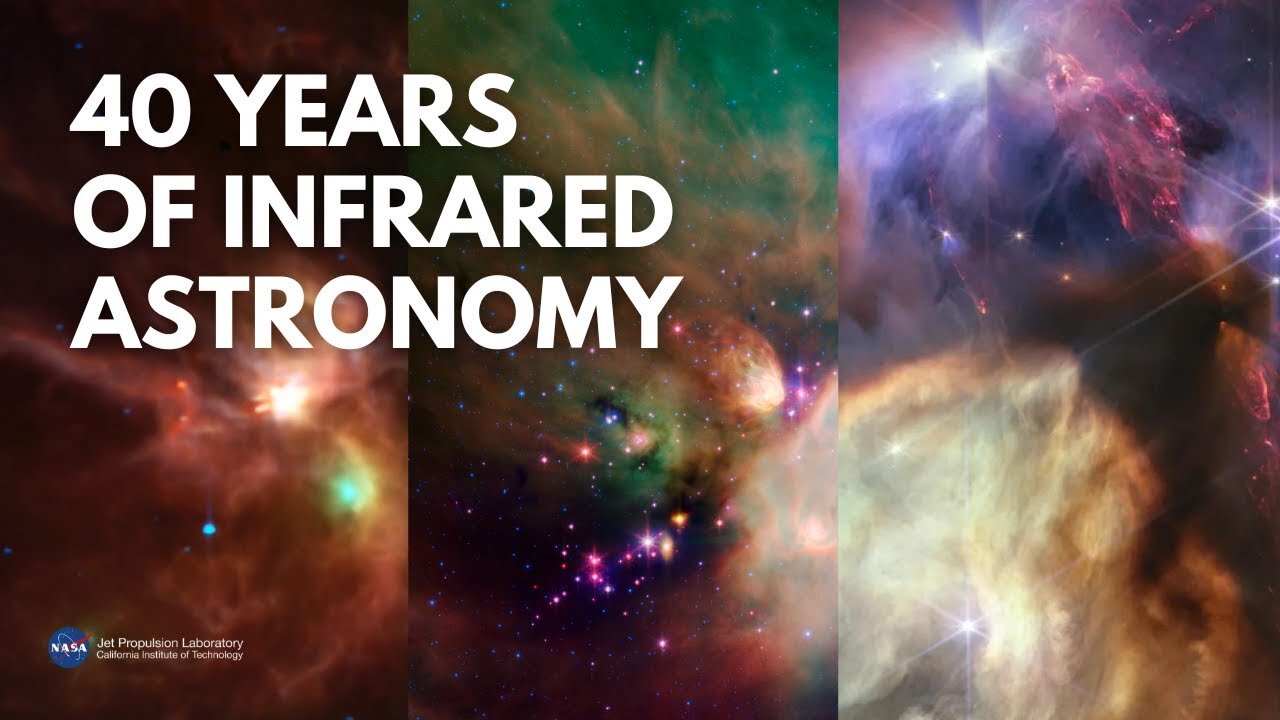Premium Only Content

NASA Telescopes Reveal an Invisible Infrared Universe
For 40 years, NASA has expanded our view of the universe with space telescopes that detect infrared light, which is invisible to the human eye. Observing the infrared realm helps us study the origins of planets, stars, galaxies, and even the universe itself.
NASA’s James Webb Space Telescope is the agency’s latest infrared space telescope, adding new insights to targets first discovered and studied by infrared missions that came before it.
Infrared space telescope missions have built upon one another to reveal stars, galaxies, and all manner of cosmic objects with ever-increasing clarity. Here you will see images from the pioneering Infrared Astronomical Satellite (IRAS), launched in 1983, the Spitzer Space Telescope, launched in 2003, and the James Webb Space Telescope, which launched in 2021 and is sending back extremely detailed images today.
For more information about Webb, visit: https://www.nasa.gov/webb
For more information about Spitzer, visit: https://www.nasa.gov/spitzer
For more information about IRAS, visit: https://www.jpl.nasa.gov/missions/inf...
Credits: IRAS images: NASA/Netherlands Agency for Aerospace Programmes/UK Science and Engineering Research Council/JPL-Caltech; Spitzer images: NASA/JPL-Caltech/IPAC; Webb images: NASA/ESA/CSA/STScI
For 40 years, NASA has expanded our view of the universe with space telescopes that detect infrared light, which is invisible to the human eye. Observing the infrared realm helps us study the origins of planets, stars, galaxies, and even the universe itself.
NASA’s James Webb Space Telescope is the agency’s latest infrared space telescope, adding new insights to targets first discovered and studied by infrared missions that came before it.
Infrared space telescope missions have built upon one another to reveal stars, galaxies, and all manner of cosmic objects with ever-increasing clarity. Here you will see images from the pioneering Infrared Astronomical Satellite (IRAS), launched in 1983, the Spitzer Space Telescope, launched in 2003, and the James Webb Space Telescope, which launched in 2021 and is sending back extremely detailed images today.
For more information about Webb, visit: https://www.nasa.gov/webb
For more information about Spitzer, visit: https://www.nasa.gov/spitzer
For more information about IRAS, visit: https://www.jpl.nasa.gov/missions/inf...
Credits: IRAS images: NASA/Netherlands Agency for Aerospace Programmes/UK Science and Engineering Research Council/JPL-Caltech; Spitzer images: NASA/JPL-Caltech/IPAC; Webb images: NASA/ESA/CSA/STScI
For 40 years, NASA has expanded our view of the universe with space telescopes that detect infrared light, which is invisible to the human eye. Observing the infrared realm helps us study the origins of planets, stars, galaxies, and even the universe itself.
NASA’s James Webb Space Telescope is the agency’s latest infrared space telescope, adding new insights to targets first discovered and studied by infrared missions that came before it.
Infrared space telescope missions have built upon one another to reveal stars, galaxies, and all manner of cosmic objects with ever-increasing clarity. Here you will see images from the pioneering Infrared Astronomical Satellite (IRAS), launched in 1983, the Spitzer Space Telescope, launched in 2003, and the James Webb Space Telescope, which launched in 2021 and is sending back extremely detailed images today.
For more information about Webb, visit: https://www.nasa.gov/webb
For more information about Spitzer, visit: https://www.nasa.gov/spitzer
For more information about IRAS, visit: https://www.jpl.nasa.gov/missions/inf...
Credits: IRAS images: NASA/Netherlands Agency for Aerospace Programmes/UK Science and Engineering Research Council/JPL-Caltech; Spitzer images: NASA/JPL-Caltech/IPAC; Webb images: NASA/ESA/CSA/STScI
For 40 years, NASA has expanded our view of the universe with space telescopes that detect infrared light, which is invisible to the human eye. Observing the infrared realm helps us study the origins of planets, stars, galaxies, and even the universe itself.
NASA’s James Webb Space Telescope is the agency’s latest infrared space telescope, adding new insights to targets first discovered and studied by infrared missions that came before it.
Infrared space telescope missions have built upon one another to reveal stars, galaxies, and all manner of cosmic objects with ever-increasing clarity. Here you will see images from the pioneering Infrared Astronomical Satellite (IRAS), launched in 1983, the Spitzer Space Telescope, launched in 2003, and the James Webb Space Telescope, which launched in 2021 and is sending back extremely detailed images today.
For more information about Webb, visit: https://www.nasa.gov/webb
For more information about Spitzer, visit: https://www.nasa.gov/spitzer
For more information about IRAS, visit: https://www.jpl.nasa.gov/missions/inf...
Credits: IRAS images: NASA/Netherlands Agency for Aerospace Programmes/UK Science and Engineering Research Council/JPL-Caltech; Spitzer images: NASA/JPL-Caltech/IPAC; Webb images: NASA/ESA/CSA/STScI
For 40 years, NASA has expanded our view of the universe with space telescopes that detect infrared light, which is invisible to the human eye. Observing the infrared realm helps us study the origins of planets, stars, galaxies, and even the universe itself.
NASA’s James Webb Space Telescope is the agency’s latest infrared space telescope, adding new insights to targets first discovered and studied by infrared missions that came before it.
Infrared space telescope missions have built upon one another to reveal stars, galaxies, and all manner of cosmic objects with ever-increasing clarity. Here you will see images from the pioneering Infrared Astronomical Satellite (IRAS), launched in 1983, the Spitzer Space Telescope, launched in 2003, and the James Webb Space Telescope, which launched in 2021 and is sending back extremely detailed images today.
For more information about Webb, visit: https://www.nasa.gov/webb
For more information about Spitzer, visit: https://www.nasa.gov/spitzer
For more information about IRAS, visit: https://www.jpl.nasa.gov/missions/inf...
Credits: IRAS images: NASA/Netherlands Agency for Aerospace Programmes/UK Science and Engineering Research Council/JPL-Caltech; Spitzer images: NASA/JPL-Caltech/IPAC; Webb images: NASA/ESA/CSA/STScI
For 40 years, NASA has expanded our view of the universe with space telescopes that detect infrared light, which is invisible to the human eye. Observing the infrared realm helps us study the origins of planets, stars, galaxies, and even the universe itself.
NASA’s James Webb Space Telescope is the agency’s latest infrared space telescope, adding new insights to targets first discovered and studied by infrared missions that came before it.
Infrared space telescope missions have built upon one another to reveal stars, galaxies, and all manner of cosmic objects with ever-increasing clarity. Here you will see images from the pioneering Infrared Astronomical Satellite (IRAS), launched in 1983, the Spitzer Space Telescope, launched in 2003, and the James Webb Space Telescope, which launched in 2021 and is sending back extremely detailed images today.
For more information about Webb, visit: https://www.nasa.gov/webb
For more information about Spitzer, visit: https://www.nasa.gov/spitzer
For more information about IRAS, visit: https://www.jpl.nasa.gov/missions/inf...
Credits: IRAS images: NASA/Netherlands Agency for Aerospace Programmes/UK Science and Engineering Research Council/JPL-Caltech; Spitzer images: NASA/JPL-Caltech/IPAC; Webb images: NASA/ESA/CSA/STScI
For 40 years, NASA has expanded our view of the universe with space telescopes that detect infrared light, which is invisible to the human eye. Observing the infrared realm helps us study the origins of planets, stars, galaxies, and even the universe itself.
NASA’s James Webb Space Telescope is the agency’s latest infrared space telescope, adding new insights to targets first discovered and studied by infrared missions that came before it.
Infrared space telescope missions have built upon one another to reveal stars, galaxies, and all manner of cosmic objects with ever-increasing clarity. Here you will see images from the pioneering Infrared Astronomical Satellite (IRAS), launched in 1983, the Spitzer Space Telescope, launched in 2003, and the James Webb Space Telescope, which launched in 2021 and is sending back extremely detailed images today.
For more information about Webb, visit: https://www.nasa.gov/webb
For more information about Spitzer, visit: https://www.nasa.gov/spitzer
For more information about IRAS, visit: https://www.jpl.nasa.gov/missions/inf...
Credits: IRAS images: NASA/Netherlands Agency for Aerospace Programmes/UK Science and Engineering Research Council/JPL-Caltech; Spitzer images: NASA/JPL-Caltech/IPAC; Webb images: NASA/ESA/CSA/STScI
For 40 years, NASA has expanded our view of the universe with space telescopes that detect infrared light, which is invisible to the human eye. Observing the infrared realm helps us study the origins of planets, stars, galaxies, and even the universe itself.
NASA’s James Webb Space Telescope is the agency’s latest infrared space telescope, adding new insights to targets first discovered and studied by infrared missions that came before it.
Infrared space telescope missions have built upon one another to reveal stars, galaxies, and all manner of cosmic objects with ever-increasing clarity. Here you will see images from the pioneering Infrared Astronomical Satellite (IRAS), launched in 1983, the Spitzer Space Telescope, launched in 2003, and the James Webb Space Telescope, which launched in 2021 and is sending back extremely detailed images today.
For more information about Webb, visit: https://www.nasa.gov/webb
For more information about Spitzer, visit: https://www.nasa.gov/spitzer
For more information about IRAS, visit: https://www.jpl.nasa.gov/missions/inf...
Credits: IRAS images: NASA/Netherlands Agency for Aerospace Programmes/UK Science and Engineering Research Council/JPL-Caltech; Spitzer images: NASA/JPL-Caltech/IPAC; Webb images: NASA/ESA/CSA/STScI
For 40 years, NASA has expanded our view of the universe with space telescopes that detect infrared light, which is invisible to the human eye. Observing the infrared realm helps us study the origins of planets, stars, galaxies, and even the universe itself.
NASA’s James Webb Space Telescope is the agency’s latest infrared space telescope, adding new insights to targets first discovered and studied by infrared missions that came before it.
Infrared space telescope missions have built upon one another to reveal stars, galaxies, and all manner of cosmic objects with ever-increasing clarity. Here you will see images from the pioneering Infrared Astronomical Satellite (IRAS), launched in 1983, the Spitzer Space Telescope, launched in 2003, and the James Webb Space Telescope, which launched in 2021 and is sending back extremely detailed images today.
For more information about Webb, visit: https://www.nasa.gov/webb
For more information about Spitzer, visit: https://www.nasa.gov/spitzer
For more information about IRAS, visit: https://www.jpl.nasa.gov/missions/inf...
Credits: IRAS images: NASA/Netherlands Agency for Aerospace Programmes/UK Science and Engineering Research Council/JPL-Caltech; Spitzer images: NASA/JPL-Caltech/IPAC; Webb images: NASA/ESA/CSA/STScI
For 40 years, NASA has expanded our view of the universe with space telescopes that detect infrared light, which is invisible to the human eye. Observing the infrared realm helps us study the origins of planets, stars, galaxies, and even the universe itself.
NASA’s James Webb Space Telescope is the agency’s latest infrared space telescope, adding new insights to targets first discovered and studied by infrared missions that came before it.
Infrared space telescope missions have built upon one another to reveal stars, galaxies, and all manner of cosmic objects with ever-increasing clarity. Here you will see images from the pioneering Infrared Astronomical Satellite (IRAS), launched in 1983, the Spitzer Space Telescope, launched in 2003, and the James Webb Space Telescope, which launched in 2021 and is sending back extremely detailed images today.
For more information about Webb, visit: https://www.nasa.gov/webb
For more information about Spitzer, visit: https://www.nasa.gov/spitzer
For more information about IRAS, visit: https://www.jpl.nasa.gov/missions/inf...
Credits: IRAS images: NASA/Netherlands Agency for Aerospace Programmes/UK Science and Engineering Research Council/JPL-Caltech; Spitzer images: NASA/JPL-Caltech/IPAC; Webb images: NASA/ESA/CSA/STScI
For 40 years, NASA has expanded our view of the universe with space telescopes that detect infrared light, which is invisible to the human eye. Observing the infrared realm helps us study the origins of planets, stars, galaxies, and even the universe itself.
NASA’s James Webb Space Telescope is the agency’s latest infrared space telescope, adding new insights to targets first discovered and studied by infrared missions that came before it.
Infrared space telescope missions have built upon one another to reveal stars, galaxies, and all manner of cosmic objects with ever-increasing clarity. Here you will see images from the pioneering Infrared Astronomical Satellite (IRAS), launched in 1983, the Spitzer Space Telescope, launched in 2003, and the James Webb Space Telescope, which launched in 2021 and is sending back extremely detailed images today.
For more information about Webb, visit: https://www.nasa.gov/webb
For more information about Spitzer, visit: https://www.nasa.gov/spitzer
For more information about IRAS, visit: https://www.jpl.nasa.gov/missions/inf...
Credits: IRAS images: NASA/Netherlands Agency for Aerospace Programmes/UK Science and Engineering Research Council/JPL-Caltech; Spitzer images: NASA/JPL-Caltech/IPAC; Webb images: NASA/ESA/CSA/STScI
For 40 years, NASA has expanded our view of the universe with space telescopes that detect infrared light, which is invisible to the human eye. Observing the infrared realm helps us study the origins of planets, stars, galaxies, and even the universe itself.
NASA’s James Webb Space Telescope is the agency’s latest infrared space telescope, adding new insights to targets first discovered and studied by infrared missions that came before it.
Infrared space telescope missions have built upon one another to reveal stars, galaxies, and all manner of cosmic objects with ever-increasing clarity. Here you will see images from the pioneering Infrared Astronomical Satellite (IRAS), launched in 1983, the Spitzer Space Telescope, launched in 2003, and the James Webb Space Telescope, which launched in 2021 and is sending back extremely detailed images today.
For more information about Webb, visit: https://www.nasa.gov/webb
For more information about Spitzer, visit: https://www.nasa.gov/spitzer
For more information about IRAS, visit: https://www.jpl.nasa.gov/missions/inf...
Credits: IRAS images: NASA/Netherlands Agency for Aerospace Programmes/UK Science and Engineering Research Council/JPL-Caltech; Spitzer images: NASA/JPL-Caltech/IPAC; Webb images: NASA/ESA/CSA/STScI
For 40 years, NASA has expanded our view of the universe with space telescopes that detect infrared light, which is invisible to the human eye. Observing the infrared realm helps us study the origins of planets, stars, galaxies, and even the universe itself.
NASA’s James Webb Space Telescope is the agency’s latest infrared space telescope, adding new insights to targets first discovered and studied by infrared missions that came before it.
Infrared space telescope missions have built upon one another to reveal stars, galaxies, and all manner of cosmic objects with ever-increasing clarity. Here you will see images from the pioneering Infrared Astronomical Satellite (IRAS), launched in 1983, the Spitzer Space Telescope, launched in 2003, and the James Webb Space Telescope, which launched in 2021 and is sending back extremely detailed images today.
For more information about Webb, visit: https://www.nasa.gov/webb
For more information about Spitzer, visit: https://www.nasa.gov/spitzer
For more information about IRAS, visit: https://www.jpl.nasa.gov/missions/inf...
Credits: IRAS images: NASA/Netherlands Agency for Aerospace Programmes/UK Science and Engineering Research Council/JPL-Caltech; Spitzer images: NASA/JPL-Caltech/IPAC; Webb images: NASA/ESA/CSA/STScI
For 40 years, NASA has expanded our view of the universe with space telescopes that detect infrared light, which is invisible to the human eye. Observing the infrared realm helps us study the origins of planets, stars, galaxies, and even the universe itself.
NASA’s James Webb Space Telescope is the agency’s latest infrared space telescope, adding new insights to targets first discovered and studied by infrared missions that came before it.
Infrared space telescope missions have built upon one another to reveal stars, galaxies, and all manner of cosmic objects with ever-increasing clarity. Here you will see images from the pioneering Infrared Astronomical Satellite (IRAS), launched in 1983, the Spitzer Space Telescope, launched in 2003, and the James Webb Space Telescope, which launched in 2021 and is sending back extremely detailed images today.
For more information about Webb, visit: https://www.nasa.gov/webb
For more information about Spitzer, visit: https://www.nasa.gov/spitzer
For more information about IRAS, visit: https://www.jpl.nasa.gov/missions/inf...
Credits: IRAS images: NASA/Netherlands Agency for Aerospace Programmes/UK Science and Engineering Research Council/JPL-Caltech; Spitzer images: NASA/JPL-Caltech/IPAC; Webb images: NASA/ESA/CSA/STScI
For 40 years, NASA has expanded our view of the universe with space telescopes that detect infrared light, which is invisible to the human eye. Observing the infrared realm helps us study the origins of planets, stars, galaxies, and even the universe itself.
NASA’s James Webb Space Telescope is the agency’s latest infrared space telescope, adding new insights to targets first discovered and studied by infrared missions that came before it.
Infrared space telescope missions have built upon one another to reveal stars, galaxies, and all manner of cosmic objects with ever-increasing clarity. Here you will see images from the pioneering Infrared Astronomical Satellite (IRAS), launched in 1983, the Spitzer Space Telescope, launched in 2003, and the James Webb Space Telescope, which launched in 2021 and is sending back extremely detailed images today.
For more information about Webb, visit: https://www.nasa.gov/webb
For more information about Spitzer, visit: https://www.nasa.gov/spitzer
For more information about IRAS, visit: https://www.jpl.nasa.gov/missions/inf...
Credits: IRAS images: NASA/Netherlands Agency for Aerospace Programmes/UK Science and Engineering Research Council/JPL-Caltech; Spitzer images: NASA/JPL-Caltech/IPAC; Webb images: NASA/ESA/CSA/STScI
For 40 years, NASA has expanded our view of the universe with space telescopes that detect infrared light, which is invisible to the human eye. Observing the infrared realm helps us study the origins of planets, stars, galaxies, and even the universe itself.
NASA’s James Webb Space Telescope is the agency’s latest infrared space telescope, adding new insights to targets first discovered and studied by infrared missions that came before it.
Infrared space telescope missions have built upon one another to reveal stars, galaxies, and all manner of cosmic objects with ever-increasing clarity. Here you will see images from the pioneering Infrared Astronomical Satellite (IRAS), launched in 1983, the Spitzer Space Telescope, launched in 2003, and the James Webb Space Telescope, which launched in 2021 and is sending back extremely detailed images today.
For more information about Webb, visit: https://www.nasa.gov/webb
For more information about Spitzer, visit: https://www.nasa.gov/spitzer
For more information about IRAS, visit: https://www.jpl.nasa.gov/missions/inf...
Credits: IRAS images: NASA/Netherlands Agency for Aerospace Programmes/UK Science and Engineering Research Council/JPL-Caltech; Spitzer images: NASA/JPL-Caltech/IPAC; Webb images: NASA/ESA/CSA/STScI
For 40 years, NASA has expanded our view of the universe with space telescopes that detect infrared light, which is invisible to the human eye. Observing the infrared realm helps us study the origins of planets, stars, galaxies, and even the universe itself.
NASA’s James Webb Space Telescope is the agency’s latest infrared space telescope, adding new insights to targets first discovered and studied by infrared missions that came before it.
Infrared space telescope missions have built upon one another to reveal stars, galaxies, and all manner of cosmic objects with ever-increasing clarity. Here you will see images from the pioneering Infrared Astronomical Satellite (IRAS), launched in 1983, the Spitzer Space Telescope, launched in 2003, and the James Webb Space Telescope, which launched in 2021 and is sending back extremely detailed images today.
For more information about Webb, visit: https://www.nasa.gov/webb
For more information about Spitzer, visit: https://www.nasa.gov/spitzer
For more information about IRAS, visit: https://www.jpl.nasa.gov/missions/inf...
Credits: IRAS images: NASA/Netherlands Agency for Aerospace Programmes/UK Science and Engineering Research Council/JPL-Caltech; Spitzer images: NASA/JPL-Caltech/IPAC; Webb images: NASA/ESA/CSA/STScI
For 40 years, NASA has expanded our view of the universe with space telescopes that detect infrared light, which is invisible to the human eye. Observing the infrared realm helps us study the origins of planets, stars, galaxies, and even the universe itself.
NASA’s James Webb Space Telescope is the agency’s latest infrared space telescope, adding new insights to targets first discovered and studied by infrared missions that came before it.
Infrared space telescope missions have built upon one another to reveal stars, galaxies, and all manner of cosmic objects with ever-increasing clarity. Here you will see images from the pioneering Infrared Astronomical Satellite (IRAS), launched in 1983, the Spitzer Space Telescope, launched in 2003, and the James Webb Space Telescope, which launched in 2021 and is sending back extremely detailed images today.
For more information about Webb, visit: https://www.nasa.gov/webb
For more information about Spitzer, visit: https://www.nasa.gov/spitzer
For more information about IRAS, visit: https://www.jpl.nasa.gov/missions/inf...
Credits: IRAS images: NASA/Netherlands Agency for Aerospace Programmes/UK Science and Engineering Research Council/JPL-Caltech; Spitzer images: NASA/JPL-Caltech/IPAC; Webb images: NASA/ESA/CSA/STScI
For 40 years, NASA has expanded our view of the universe with space telescopes that detect infrared light, which is invisible to the human eye. Observing the infrared realm helps us study the origins of planets, stars, galaxies, and even the universe itself.
NASA’s James Webb Space Telescope is the agency’s latest infrared space telescope, adding new insights to targets first discovered and studied by infrared missions that came before it.
Infrared space telescope missions have built upon one another to reveal stars, galaxies, and all manner of cosmic objects with ever-increasing clarity. Here you will see images from the pioneering Infrared Astronomical Satellite (IRAS), launched in 1983, the Spitzer Space Telescope, launched in 2003, and the James Webb Space Telescope, which launched in 2021 and is sending back extremely detailed images today.
For more information about Webb, visit: https://www.nasa.gov/webb
For more information about Spitzer, visit: https://www.nasa.gov/spitzer
For more information about IRAS, visit: https://www.jpl.nasa.gov/missions/inf...
Credits: IRAS images: NASA/Netherlands Agency for Aerospace Programmes/UK Science and Engineering Research Council/JPL-Caltech; Spitzer images: NASA/JPL-Caltech/IPAC; Webb images: NASA/ESA/CSA/STScI
For 40 years, NASA has expanded our view of the universe with space telescopes that detect infrared light, which is invisible to the human eye. Observing the infrared realm helps us study the origins of planets, stars, galaxies, and even the universe itself.
NASA’s James Webb Space Telescope is the agency’s latest infrared space telescope, adding new insights to targets first discovered and studied by infrared missions that came before it.
Infrared space telescope missions have built upon one another to reveal stars, galaxies, and all manner of cosmic objects with ever-increasing clarity. Here you will see images from the pioneering Infrared Astronomical Satellite (IRAS), launched in 1983, the Spitzer Space Telescope, launched in 2003, and the James Webb Space Telescope, which launched in 2021 and is sending back extremely detailed images today.
For more information about Webb, visit: https://www.nasa.gov/webb
For more information about Spitzer, visit: https://www.nasa.gov/spitzer
For more information about IRAS, visit: https://www.jpl.nasa.gov/missions/inf...
Credits: IRAS images: NASA/Netherlands Agency for Aerospace Programmes/UK Science and Engineering Research Council/JPL-Caltech; Spitzer images: NASA/JPL-Caltech/IPAC; Webb images: NASA/ESA/CSA/STScI
For 40 years, NASA has expanded our view of the universe with space telescopes that detect infrared light, which is invisible to the human eye. Observing the infrared realm helps us study the origins of planets, stars, galaxies, and even the universe itself.
NASA’s James Webb Space Telescope is the agency’s latest infrared space telescope, adding new insights to targets first discovered and studied by infrared missions that came before it.
Infrared space telescope missions have built upon one another to reveal stars, galaxies, and all manner of cosmic objects with ever-increasing clarity. Here you will see images from the pioneering Infrared Astronomical Satellite (IRAS), launched in 1983, the Spitzer Space Telescope, launched in 2003, and the James Webb Space Telescope, which launched in 2021 and is sending back extremely detailed images today.
For more information about Webb, visit: https://www.nasa.gov/webb
For more information about Spitzer, visit: https://www.nasa.gov/spitzer
For more information about IRAS, visit: https://www.jpl.nasa.gov/missions/inf...
Credits: IRAS images: NASA/Netherlands Agency for Aerospace Programmes/UK Science and Engineering Research Council/JPL-Caltech; Spitzer images: NASA/JPL-Caltech/IPAC; Webb images: NASA/ESA/CSA/STScI
For 40 years, NASA has expanded our view of the universe with space telescopes that detect infrared light, which is invisible to the human eye. Observing the infrared realm helps us study the origins of planets, stars, galaxies, and even the universe itself.
NASA’s James Webb Space Telescope is the agency’s latest infrared space telescope, adding new insights to targets first discovered and studied by infrared missions that came before it.
Infrared space telescope missions have built upon one another to reveal stars, galaxies, and all manner of cosmic objects with ever-increasing clarity. Here you will see images from the pioneering Infrared Astronomical Satellite (IRAS), launched in 1983, the Spitzer Space Telescope, launched in 2003, and the James Webb Space Telescope, which launched in 2021 and is sending back extremely detailed images today.
For more information about Webb, visit: https://www.nasa.gov/webb
For more information about Spitzer, visit: https://www.nasa.gov/spitzer
For more information about IRAS, visit: https://www.jpl.nasa.gov/missions/inf...
Credits: IRAS images: NASA/Netherlands Agency for Aerospace Programmes/UK Science and Engineering Research Council/JPL-Caltech; Spitzer images: NASA/JPL-Caltech/IPAC; Webb images: NASA/ESA/CSA/STScI
For 40 years, NASA has expanded our view of the universe with space telescopes that detect infrared light, which is invisible to the human eye. Observing the infrared realm helps us study the origins of planets, stars, galaxies, and even the universe itself.
NASA’s James Webb Space Telescope is the agency’s latest infrared space telescope, adding new insights to targets first discovered and studied by infrared missions that came before it.
Infrared space telescope missions have built upon one another to reveal stars, galaxies, and all manner of cosmic objects with ever-increasing clarity. Here you will see images from the pioneering Infrared Astronomical Satellite (IRAS), launched in 1983, the Spitzer Space Telescope, launched in 2003, and the James Webb Space Telescope, which launched in 2021 and is sending back extremely detailed images today.
For more information about Webb, visit: https://www.nasa.gov/webb
For more information about Spitzer, visit: https://www.nasa.gov/spitzer
For more information about IRAS, visit: https://www.jpl.nasa.gov/missions/inf...
Credits: IRAS images: NASA/Netherlands Agency for Aerospace Programmes/UK Science and Engineering Research Council/JPL-Caltech; Spitzer images: NASA/JPL-Caltech/IPAC; Webb images: NASA/ESA/CSA/STScI
For 40 years, NASA has expanded our view of the universe with space telescopes that detect infrared light, which is invisible to the human eye. Observing the infrared realm helps us study the origins of planets, stars, galaxies, and even the universe itself.
NASA’s James Webb Space Telescope is the agency’s latest infrared space telescope, adding new insights to targets first discovered and studied by infrared missions that came before it.
Infrared space telescope missions have built upon one another to reveal stars, galaxies, and all manner of cosmic objects with ever-increasing clarity. Here you will see images from the pioneering Infrared Astronomical Satellite (IRAS), launched in 1983, the Spitzer Space Telescope, launched in 2003, and the James Webb Space Telescope, which launched in 2021 and is sending back extremely detailed images today.
For more information about Webb, visit: https://www.nasa.gov/webb
For more information about Spitzer, visit: https://www.nasa.gov/spitzer
For more information about IRAS, visit: https://www.jpl.nasa.gov/missions/inf...
Credits: IRAS images: NASA/Netherlands Agency for Aerospace Programmes/UK Science and Engineering Research Council/JPL-Caltech; Spitzer images: NASA/JPL-Caltech/IPAC; Webb images: NASA/ESA/CSA/STScI
For 40 years, NASA has expanded our view of the universe with space telescopes that detect infrared light, which is invisible to the human eye. Observing the infrared realm helps us study the origins of planets, stars, galaxies, and even the universe itself.
NASA’s James Webb Space Telescope is the agency’s latest infrared space telescope, adding new insights to targets first discovered and studied by infrared missions that came before it.
Infrared space telescope missions have built upon one another to reveal stars, galaxies, and all manner of cosmic objects with ever-increasing clarity. Here you will see images from the pioneering Infrared Astronomical Satellite (IRAS), launched in 1983, the Spitzer Space Telescope, launched in 2003, and the James Webb Space Telescope, which launched in 2021 and is sending back extremely detailed images today.
For more information about Webb, visit: https://www.nasa.gov/webb
For more information about Spitzer, visit: https://www.nasa.gov/spitzer
For more information about IRAS, visit: https://www.jpl.nasa.gov/missions/inf...
Credits: IRAS images: NASA/Netherlands Agency for Aerospace Programmes/UK Science and Engineering Research Council/JPL-Caltech; Spitzer images: NASA/JPL-Caltech/IPAC; Webb images: NASA/ESA/CSA/STScI
For 40 years, NASA has expanded our view of the universe with space telescopes that detect infrared light, which is invisible to the human eye. Observing the infrared realm helps us study the origins of planets, stars, galaxies, and even the universe itself.
NASA’s James Webb Space Telescope is the agency’s latest infrared space telescope, adding new insights to targets first discovered and studied by infrared missions that came before it.
Infrared space telescope missions have built upon one another to reveal stars, galaxies, and all manner of cosmic objects with ever-increasing clarity. Here you will see images from the pioneering Infrared Astronomical Satellite (IRAS), launched in 1983, the Spitzer Space Telescope, launched in 2003, and the James Webb Space Telescope, which launched in 2021 and is sending back extremely detailed images today.
For more information about Webb, visit: https://www.nasa.gov/webb
For more information about Spitzer, visit: https://www.nasa.gov/spitzer
For more information about IRAS, visit: https://www.jpl.nasa.gov/missions/inf...
Credits: IRAS images: NASA/Netherlands Agency for Aerospace Programmes/UK Science and Engineering Research Council/JPL-Caltech; Spitzer images: NASA/JPL-Caltech/IPAC; Webb images: NASA/ESA/CSA/STScI
For 40 years, NASA has expanded our view of the universe with space telescopes that detect infrared light, which is invisible to the human eye. Observing the infrared realm helps us study the origins of planets, stars, galaxies, and even the universe itself.
NASA’s James Webb Space Telescope is the agency’s latest infrared space telescope, adding new insights to targets first discovered and studied by infrared missions that came before it.
Infrared space telescope missions have built upon one another to reveal stars, galaxies, and all manner of cosmic objects with ever-increasing clarity. Here you will see images from the pioneering Infrared Astronomical Satellite (IRAS), launched in 1983, the Spitzer Space Telescope, launched in 2003, and the James Webb Space Telescope, which launched in 2021 and is sending back extremely detailed images today.
For more information about Webb, visit: https://www.nasa.gov/webb
For more information about Spitzer, visit: https://www.nasa.gov/spitzer
For more information about IRAS, visit: https://www.jpl.nasa.gov/missions/inf...
Credits: IRAS images: NASA/Netherlands Agency for Aerospace Programmes/UK Science and Engineering Research Council/JPL-Caltech; Spitzer images: NASA/JPL-Caltech/IPAC; Webb images: NASA/ESA/CSA/STScI
For 40 years, NASA has expanded our view of the universe with space telescopes that detect infrared light, which is invisible to the human eye. Observing the infrared realm helps us study the origins of planets, stars, galaxies, and even the universe itself.
NASA’s James Webb Space Telescope is the agency’s latest infrared space telescope, adding new insights to targets first discovered and studied by infrared missions that came before it.
Infrared space telescope missions have built upon one another to reveal stars, galaxies, and all manner of cosmic objects with ever-increasing clarity. Here you will see images from the pioneering Infrared Astronomical Satellite (IRAS), launched in 1983, the Spitzer Space Telescope, launched in 2003, and the James Webb Space Telescope, which launched in 2021 and is sending back extremely detailed images today.
For more information about Webb, visit: https://www.nasa.gov/webb
For more information about Spitzer, visit: https://www.nasa.gov/spitzer
For more information about IRAS, visit: https://www.jpl.nasa.gov/missions/inf...
Credits: IRAS images: NASA/Netherlands Agency for Aerospace Programmes/UK Science and Engineering Research Council/JPL-Caltech; Spitzer images: NASA/JPL-Caltech/IPAC; Webb images: NASA/ESA/CSA/STScI
For 40 years, NASA has expanded our view of the universe with space telescopes that detect infrared light, which is invisible to the human eye. Observing the infrared realm helps us study the origins of planets, stars, galaxies, and even the universe itself.
NASA’s James Webb Space Telescope is the agency’s latest infrared space telescope, adding new insights to targets first discovered and studied by infrared missions that came before it.
Infrared space telescope missions have built upon one another to reveal stars, galaxies, and all manner of cosmic objects with ever-increasing clarity. Here you will see images from the pioneering Infrared Astronomical Satellite (IRAS), launched in 1983, the Spitzer Space Telescope, launched in 2003, and the James Webb Space Telescope, which launched in 2021 and is sending back extremely detailed images today.
For more information about Webb, visit: https://www.nasa.gov/webb
For more information about Spitzer, visit: https://www.nasa.gov/spitzer
For more information about IRAS, visit: https://www.jpl.nasa.gov/missions/inf...
Credits: IRAS images: NASA/Netherlands Agency for Aerospace Programmes/UK Science and Engineering Research Council/JPL-Caltech; Spitzer images: NASA/JPL-Caltech/IPAC; Webb images: NASA/ESA/CSA/STScI
For 40 years, NASA has expanded our view of the universe with space telescopes that detect infrared light, which is invisible to the human eye. Observing the infrared realm helps us study the origins of planets, stars, galaxies, and even the universe itself.
NASA’s James Webb Space Telescope is the agency’s latest infrared space telescope, adding new insights to targets first discovered and studied by infrared missions that came before it.
Infrared space telescope missions have built upon one another to reveal stars, galaxies, and all manner of cosmic objects with ever-increasing clarity. Here you will see images from the pioneering Infrared Astronomical Satellite (IRAS), launched in 1983, the Spitzer Space Telescope, launched in 2003, and the James Webb Space Telescope, which launched in 2021 and is sending back extremely detailed images today.
For more information about Webb, visit: https://www.nasa.gov/webb
For more information about Spitzer, visit: https://www.nasa.gov/spitzer
For more information about IRAS, visit: https://www.jpl.nasa.gov/missions/inf...
Credits: IRAS images: NASA/Netherlands Agency for Aerospace Programmes/UK Science and Engineering Research Council/JPL-Caltech; Spitzer images: NASA/JPL-Caltech/IPAC; Webb images: NASA/ESA/CSA/STScI
For 40 years, NASA has expanded our view of the universe with space telescopes that detect infrared light, which is invisible to the human eye. Observing the infrared realm helps us study the origins of planets, stars, galaxies, and even the universe itself.
NASA’s James Webb Space Telescope is the agency’s latest infrared space telescope, adding new insights to targets first discovered and studied by infrared missions that came before it.
Infrared space telescope missions have built upon one another to reveal stars, galaxies, and all manner of cosmic objects with ever-increasing clarity. Here you will see images from the pioneering Infrared Astronomical Satellite (IRAS), launched in 1983, the Spitzer Space Telescope, launched in 2003, and the James Webb Space Telescope, which launched in 2021 and is sending back extremely detailed images today.
For more information about Webb, visit: https://www.nasa.gov/webb
For more information about Spitzer, visit: https://www.nasa.gov/spitzer
For more information about IRAS, visit: https://www.jpl.nasa.gov/missions/inf...
Credits: IRAS images: NASA/Netherlands Agency for Aerospace Programmes/UK Science and Engineering Research Council/JPL-Caltech; Spitzer images: NASA/JPL-Caltech/IPAC; Webb images: NASA/ESA/CSA/STScI
For 40 years, NASA has expanded our view of the universe with space telescopes that detect infrared light, which is invisible to the human eye. Observing the infrared realm helps us study the origins of planets, stars, galaxies, and even the universe itself.
NASA’s James Webb Space Telescope is the agency’s latest infrared space telescope, adding new insights to targets first discovered and studied by infrared missions that came before it.
Infrared space telescope missions have built upon one another to reveal stars, galaxies, and all manner of cosmic objects with ever-increasing clarity. Here you will see images from the pioneering Infrared Astronomical Satellite (IRAS), launched in 1983, the Spitzer Space Telescope, launched in 2003, and the James Webb Space Telescope, which launched in 2021 and is sending back extremely detailed images today.
For more information about Webb, visit: https://www.nasa.gov/webb
For more information about Spitzer, visit: https://www.nasa.gov/spitzer
For more information about IRAS, visit: https://www.jpl.nasa.gov/missions/inf...
Credits: IRAS images: NASA/Netherlands Agency for Aerospace Programmes/UK Science and Engineering Research Council/JPL-Caltech; Spitzer images: NASA/JPL-Caltech/IPAC; Webb images: NASA/ESA/CSA/STScI
For 40 years, NASA has expanded our view of the universe with space telescopes that detect infrared light, which is invisible to the human eye. Observing the infrared realm helps us study the origins of planets, stars, galaxies, and even the universe itself.
NASA’s James Webb Space Telescope is the agency’s latest infrared space telescope, adding new insights to targets first discovered and studied by infrared missions that came before it.
Infrared space telescope missions have built upon one another to reveal stars, galaxies, and all manner of cosmic objects with ever-increasing clarity. Here you will see images from the pioneering Infrared Astronomical Satellite (IRAS), launched in 1983, the Spitzer Space Telescope, launched in 2003, and the James Webb Space Telescope, which launched in 2021 and is sending back extremely detailed images today.
For more information about Webb, visit: https://www.nasa.gov/webb
For more information about Spitzer, visit: https://www.nasa.gov/spitzer
For more information about IRAS, visit: https://www.jpl.nasa.gov/missions/inf...
Credits: IRAS images: NASA/Netherlands Agency for Aerospace Programmes/UK Science and Engineering Research Council/JPL-Caltech; Spitzer images: NASA/JPL-Caltech/IPAC; Webb images: NASA/ESA/CSA/STScI
For 40 years, NASA has expanded our view of the universe with space telescopes that detect infrared light, which is invisible to the human eye. Observing the infrared realm helps us study the origins of planets, stars, galaxies, and even the universe itself.
NASA’s James Webb Space Telescope is the agency’s latest infrared space telescope, adding new insights to targets first discovered and studied by infrared missions that came before it.
Infrared space telescope missions have built upon one another to reveal stars, galaxies, and all manner of cosmic objects with ever-increasing clarity. Here you will see images from the pioneering Infrared Astronomical Satellite (IRAS), launched in 1983, the Spitzer Space Telescope, launched in 2003, and the James Webb Space Telescope, which launched in 2021 and is sending back extremely detailed images today.
For more information about Webb, visit: https://www.nasa.gov/webb
For more information about Spitzer, visit: https://www.nasa.gov/spitzer
For more information about IRAS, visit: https://www.jpl.nasa.gov/missions/inf...
Credits: IRAS images: NASA/Netherlands Agency for Aerospace Programmes/UK Science and Engineering Research Council/JPL-Caltech; Spitzer images: NASA/JPL-Caltech/IPAC; Webb images: NASA/ESA/CSA/STScI
For 40 years, NASA has expanded our view of the universe with space telescopes that detect infrared light, which is invisible to the human eye. Observing the infrared realm helps us study the origins of planets, stars, galaxies, and even the universe itself.
NASA’s James Webb Space Telescope is the agency’s latest infrared space telescope, adding new insights to targets first discovered and studied by infrared missions that came before it.
Infrared space telescope missions have built upon one another to reveal stars, galaxies, and all manner of cosmic objects with ever-increasing clarity. Here you will see images from the pioneering Infrared Astronomical Satellite (IRAS), launched in 1983, the Spitzer Space Telescope, launched in 2003, and the James Webb Space Telescope, which launched in 2021 and is sending back extremely detailed images today.
For more information about Webb, visit: https://www.nasa.gov/webb
For more information about Spitzer, visit: https://www.nasa.gov/spitzer
For more information about IRAS, visit: https://www.jpl.nasa.gov/missions/inf...
Credits: IRAS images: NASA/Netherlands Agency for Aerospace Programmes/UK Science and Engineering Research Council/JPL-Caltech; Spitzer images: NASA/JPL-Caltech/IPAC; Webb images: NASA/ESA/CSA/STScI
For 40 years, NASA has expanded our view of the universe with space telescopes that detect infrared light, which is invisible to the human eye. Observing the infrared realm helps us study the origins of planets, stars, galaxies, and even the universe itself.
NASA’s James Webb Space Telescope is the agency’s latest infrared space telescope, adding new insights to targets first discovered and studied by infrared missions that came before it.
Infrared space telescope missions have built upon one another to reveal stars, galaxies, and all manner of cosmic objects with ever-increasing clarity. Here you will see images from the pioneering Infrared Astronomical Satellite (IRAS), launched in 1983, the Spitzer Space Telescope, launched in 2003, and the James Webb Space Telescope, which launched in 2021 and is sending back extremely detailed images today.
For more information about Webb, visit: https://www.nasa.gov/webb
For more information about Spitzer, visit: https://www.nasa.gov/spitzer
For more information about IRAS, visit: https://www.jpl.nasa.gov/missions/inf...
Credits: IRAS images: NASA/Netherlands Agency for Aerospace Programmes/UK Science and Engineering Research Council/JPL-Caltech; Spitzer images: NASA/JPL-Caltech/IPAC; Webb images: NASA/ESA/CSA/STScI
For 40 years, NASA has expanded our view of the universe with space telescopes that detect infrared light, which is invisible to the human eye. Observing the infrared realm helps us study the origins of planets, stars, galaxies, and even the universe itself.
NASA’s James Webb Space Telescope is the agency’s latest infrared space telescope, adding new insights to targets first discovered and studied by infrared missions that came before it.
Infrared space telescope missions have built upon one another to reveal stars, galaxies, and all manner of cosmic objects with ever-increasing clarity. Here you will see images from the pioneering Infrared Astronomical Satellite (IRAS), launched in 1983, the Spitzer Space Telescope, launched in 2003, and the James Webb Space Telescope, which launched in 2021 and is sending back extremely detailed images today.
For more information about Webb, visit: https://www.nasa.gov/webb
For more information about Spitzer, visit: https://www.nasa.gov/spitzer
For more information about IRAS, visit: https://www.jpl.nasa.gov/missions/inf...
Credits: IRAS images: NASA/Netherlands Agency for Aerospace Programmes/UK Science and Engineering Research Council/JPL-Caltech; Spitzer images: NASA/JPL-Caltech/IPAC; Webb images: NASA/ESA/CSA/STScI
For 40 years, NASA has expanded our view of the universe with space telescopes that detect infrared light, which is invisible to the human eye. Observing the infrared realm helps us study the origins of planets, stars, galaxies, and even the universe itself.
NASA’s James Webb Space Telescope is the agency’s latest infrared space telescope, adding new insights to targets first discovered and studied by infrared missions that came before it.
Infrared space telescope missions have built upon one another to reveal stars, galaxies, and all manner of cosmic objects with ever-increasing clarity. Here you will see images from the pioneering Infrared Astronomical Satellite (IRAS), launched in 1983, the Spitzer Space Telescope, launched in 2003, and the James Webb Space Telescope, which launched in 2021 and is sending back extremely detailed images today.
For more information about Webb, visit: https://www.nasa.gov/webb
For more information about Spitzer, visit: https://www.nasa.gov/spitzer
For more information about IRAS, visit: https://www.jpl.nasa.gov/missions/inf...
Credits: IRAS images: NASA/Netherlands Agency for Aerospace Programmes/UK Science and Engineering Research Council/JPL-Caltech; Spitzer images: NASA/JPL-Caltech/IPAC; Webb images: NASA/ESA/CSA/STScI
For 40 years, NASA has expanded our view of the universe with space telescopes that detect infrared light, which is invisible to the human eye. Observing the infrared realm helps us study the origins of planets, stars, galaxies, and even the universe itself.
NASA’s James Webb Space Telescope is the agency’s latest infrared space telescope, adding new insights to targets first discovered and studied by infrared missions that came before it.
Infrared space telescope missions have built upon one another to reveal stars, galaxies, and all manner of cosmic objects with ever-increasing clarity. Here you will see images from the pioneering Infrared Astronomical Satellite (IRAS), launched in 1983, the Spitzer Space Telescope, launched in 2003, and the James Webb Space Telescope, which launched in 2021 and is sending back extremely detailed images today.
For more information about Webb, visit: https://www.nasa.gov/webb
For more information about Spitzer, visit: https://www.nasa.gov/spitzer
For more information about IRAS, visit: https://www.jpl.nasa.gov/missions/inf...
Credits: IRAS images: NASA/Netherlands Agency for Aerospace Programmes/UK Science and Engineering Research Council/JPL-Caltech; Spitzer images: NASA/JPL-Caltech/IPAC; Webb images: NASA/ESA/CSA/STScI
For 40 years, NASA has expanded our view of the universe with space telescopes that detect infrared light, which is invisible to the human eye. Observing the infrared realm helps us study the origins of planets, stars, galaxies, and even the universe itself.
NASA’s James Webb Space Telescope is the agency’s latest infrared space telescope, adding new insights to targets first discovered and studied by infrared missions that came before it.
Infrared space telescope missions have built upon one another to reveal stars, galaxies, and all manner of cosmic objects with ever-increasing clarity. Here you will see images from the pioneering Infrared Astronomical Satellite (IRAS), launched in 1983, the Spitzer Space Telescope, launched in 2003, and the James Webb Space Telescope, which launched in 2021 and is sending back extremely detailed images today.
For more information about Webb, visit: https://www.nasa.gov/webb
For more information about Spitzer, visit: https://www.nasa.gov/spitzer
For more information about IRAS, visit: https://www.jpl.nasa.gov/missions/inf...
Credits: IRAS images: NASA/Netherlands Agency for Aerospace Programmes/UK Science and Engineering Research Council/JPL-Caltech; Spitzer images: NASA/JPL-Caltech/IPAC; Webb images: NASA/ESA/CSA/STScI
For 40 years, NASA has expanded our view of the universe with space telescopes that detect infrared light, which is invisible to the human eye. Observing the infrared realm helps us study the origins of planets, stars, galaxies, and even the universe itself.
NASA’s James Webb Space Telescope is the agency’s latest infrared space telescope, adding new insights to targets first discovered and studied by infrared missions that came before it.
Infrared space telescope missions have built upon one another to reveal stars, galaxies, and all manner of cosmic objects with ever-increasing clarity. Here you will see images from the pioneering Infrared Astronomical Satellite (IRAS), launched in 1983, the Spitzer Space Telescope, launched in 2003, and the James Webb Space Telescope, which launched in 2021 and is sending back extremely detailed images today.
For more information about Webb, visit: https://www.nasa.gov/webb
For more information about Spitzer, visit: https://www.nasa.gov/spitzer
For more information about IRAS, visit: https://www.jpl.nasa.gov/missions/inf...
Credits: IRAS images: NASA/Netherlands Agency for Aerospace Programmes/UK Science and Engineering Research Council/JPL-Caltech; Spitzer images: NASA/JPL-Caltech/IPAC; Webb images: NASA/ESA/CSA/STScI
For 40 years, NASA has expanded our view of the universe with space telescopes that detect infrared light, which is invisible to the human eye. Observing the infrared realm helps us study the origins of planets, stars, galaxies, and even the universe itself.
NASA’s James Webb Space Telescope is the agency’s latest infrared space telescope, adding new insights to targets first discovered and studied by infrared missions that came before it.
Infrared space telescope missions have built upon one another to reveal stars, galaxies, and all manner of cosmic objects with ever-increasing clarity. Here you will see images from the pioneering Infrared Astronomical Satellite (IRAS), launched in 1983, the Spitzer Space Telescope, launched in 2003, and the James Webb Space Telescope, which launched in 2021 and is sending back extremely detailed images today.
For more information about Webb, visit: https://www.nasa.gov/webb
For more information about Spitzer, visit: https://www.nasa.gov/spitzer
For more information about IRAS, visit: https://www.jpl.nasa.gov/missions/inf...
Credits: IRAS images: NASA/Netherlands Agency for Aerospace Programmes/UK Science and Engineering Research Council/JPL-Caltech; Spitzer images: NASA/JPL-Caltech/IPAC; Webb images: NASA/ESA/CSA/STScI
For 40 years, NASA has expanded our view of the universe with space telescopes that detect infrared light, which is invisible to the human eye. Observing the infrared realm helps us study the origins of planets, stars, galaxies, and even the universe itself.
NASA’s James Webb Space Telescope is the agency’s latest infrared space telescope, adding new insights to targets first discovered and studied by infrared missions that came before it.
Infrared space telescope missions have built upon one another to reveal stars, galaxies, and all manner of cosmic objects with ever-increasing clarity. Here you will see images from the pioneering Infrared Astronomical Satellite (IRAS), launched in 1983, the Spitzer Space Telescope, launched in 2003, and the James Webb Space Telescope, which launched in 2021 and is sending back extremely detailed images today.
For more information about Webb, visit: https://www.nasa.gov/webb
For more information about Spitzer, visit: https://www.nasa.gov/spitzer
For more information about IRAS, visit: https://www.jpl.nasa.gov/missions/inf...
Credits: IRAS images: NASA/Netherlands Agency for Aerospace Programmes/UK Science and Engineering Research Council/JPL-Caltech; Spitzer images: NASA/JPL-Caltech/IPAC; Webb images: NASA/ESA/CSA/STScI
For 40 years, NASA has expanded our view of the universe with space telescopes that detect infrared light, which is invisible to the human eye. Observing the infrared realm helps us study the origins of planets, stars, galaxies, and even the universe itself.
NASA’s James Webb Space Telescope is the agency’s latest infrared space telescope, adding new insights to targets first discovered and studied by infrared missions that came before it.
Infrared space telescope missions have built upon one another to reveal stars, galaxies, and all manner of cosmic objects with ever-increasing clarity. Here you will see images from the pioneering Infrared Astronomical Satellite (IRAS), launched in 1983, the Spitzer Space Telescope, launched in 2003, and the James Webb Space Telescope, which launched in 2021 and is sending back extremely detailed images today.
For more information about Webb, visit: https://www.nasa.gov/webb
For more information about Spitzer, visit: https://www.nasa.gov/spitzer
For more information about IRAS, visit: https://www.jpl.nasa.gov/missions/inf...
Credits: IRAS images: NASA/Netherlands Agency for Aerospace Programmes/UK Science and Engineering Research Council/JPL-Caltech; Spitzer images: NASA/JPL-Caltech/IPAC; Webb images: NASA/ESA/CSA/STScI
For 40 years, NASA has expanded our view of the universe with space telescopes that detect infrared light, which is invisible to the human eye. Observing the infrared realm helps us study the origins of planets, stars, galaxies, and even the universe itself.
NASA’s James Webb Space Telescope is the agency’s latest infrared space telescope, adding new insights to targets first discovered and studied by infrared missions that came before it.
Infrared space telescope missions have built upon one another to reveal stars, galaxies, and all manner of cosmic objects with ever-increasing clarity. Here you will see images from the pioneering Infrared Astronomical Satellite (IRAS), launched in 1983, the Spitzer Space Telescope, launched in 2003, and the James Webb Space Telescope, which launched in 2021 and is sending back extremely detailed images today.
For more information about Webb, visit: https://www.nasa.gov/webb
For more information about Spitzer, visit: https://www.nasa.gov/spitzer
For more information about IRAS, visit: https://www.jpl.nasa.gov/missions/inf...
Credits: IRAS images: NASA/Netherlands Agency for Aerospace Programmes/UK Science and Engineering Research Council/JPL-Caltech; Spitzer images: NASA/JPL-Caltech/IPAC; Webb images: NASA/ESA/CSA/STScI
For 40 years, NASA has expanded our view of the universe with space telescopes that detect infrared light, which is invisible to the human eye. Observing the infrared realm helps us study the origins of planets, stars, galaxies, and even the universe itself.
NASA’s James Webb Space Telescope is the agency’s latest infrared space telescope, adding new insights to targets first discovered and studied by infrared missions that came before it.
Infrared space telescope missions have built upon one another to reveal stars, galaxies, and all manner of cosmic objects with ever-increasing clarity. Here you will see images from the pioneering Infrared Astronomical Satellite (IRAS), launched in 1983, the Spitzer Space Telescope, launched in 2003, and the James Webb Space Telescope, which launched in 2021 and is sending back extremely detailed images today.
For more information about Webb, visit: https://www.nasa.gov/webb
For more information about Spitzer, visit: https://www.nasa.gov/spitzer
For more information about IRAS, visit: https://www.jpl.nasa.gov/missions/inf...
Credits: IRAS images: NASA/Netherlands Agency for Aerospace Programmes/UK Science and Engineering Research Council/JPL-Caltech; Spitzer images: NASA/JPL-Caltech/IPAC; Webb images: NASA/ESA/CSA/STScI
For 40 years, NASA has expanded our view of the universe with space telescopes that detect infrared light, which is invisible to the human eye. Observing the infrared realm helps us study the origins of planets, stars, galaxies, and even the universe itself.
NASA’s James Webb Space Telescope is the agency’s latest infrared space telescope, adding new insights to targets first discovered and studied by infrared missions that came before it.
Infrared space telescope missions have built upon one another to reveal stars, galaxies, and all manner of cosmic objects with ever-increasing clarity. Here you will see images from the pioneering Infrared Astronomical Satellite (IRAS), launched in 1983, the Spitzer Space Telescope, launched in 2003, and the James Webb Space Telescope, which launched in 2021 and is sending back extremely detailed images today.
For more information about Webb, visit: https://www.nasa.gov/webb
For more information about Spitzer, visit: https://www.nasa.gov/spitzer
For more information about IRAS, visit: https://www.jpl.nasa.gov/missions/inf...
Credits: IRAS images: NASA/Netherlands Agency for Aerospace Programmes/UK Science and Engineering Research Council/JPL-Caltech; Spitzer images: NASA/JPL-Caltech/IPAC; Webb images: NASA/ESA/CSA/STScI
For 40 years, NASA has expanded our view of the universe with space telescopes that detect infrared light, which is invisible to the human eye. Observing the infrared realm helps us study the origins of planets, stars, galaxies, and even the universe itself.
NASA’s James Webb Space Telescope is the agency’s latest infrared space telescope, adding new insights to targets first discovered and studied by infrared missions that came before it.
Infrared space telescope missions have built upon one another to reveal stars, galaxies, and all manner of cosmic objects with ever-increasing clarity. Here you will see images from the pioneering Infrared Astronomical Satellite (IRAS), launched in 1983, the Spitzer Space Telescope, launched in 2003, and the James Webb Space Telescope, which launched in 2021 and is sending back extremely detailed images today.
For more information about Webb, visit: https://www.nasa.gov/webb
For more information about Spitzer, visit: https://www.nasa.gov/spitzer
For more information about IRAS, visit: https://www.jpl.nasa.gov/missions/inf...
Credits: IRAS images: NASA/Netherlands Agency for Aerospace Programmes/UK Science and Engineering Research Council/JPL-Caltech; Spitzer images: NASA/JPL-Caltech/IPAC; Webb images: NASA/ESA/CSA/STScI
-
 LIVE
LIVE
VINCE
2 hours agoDemocrats Get Exposed By Their Own Vote | Episode 172 - 11/19/25
28,790 watching -
 LIVE
LIVE
Benny Johnson
1 hour ago🚨PANIC: Clintons Threatened With ARREST Over REFUSING Epstein Testimony | Files Release Imminent…
5,661 watching -
 LIVE
LIVE
LFA TV
14 hours agoLIVE & BREAKING NEWS! | WEDNESDAY 11/19/25
3,491 watching -
 1:41:54
1:41:54
Graham Allen
2 hours agoEpstein Files WILL BE RELEASED!! Not How You Think! + Kirk’s Head Of Security Exposes ALL!!
116K691 -
 LIVE
LIVE
Badlands Media
8 hours agoBadlands Daily: November 19, 2025
3,271 watching -
 LIVE
LIVE
Committee on House Administration
20 hours agoFull Committee Hearing: “Taking Stock of the STOCK Act”
109 watching -
 LIVE
LIVE
Wendy Bell Radio
6 hours agoTruth Is A 4 Letter Word
7,314 watching -
 LIVE
LIVE
Major League Fishing
6 days agoLIVE! - Fishing Clash Team Series: Summit Cup - Day 4
170 watching -
 LIVE
LIVE
The Big Mig™
3 hours agoEpstein Files Transparency Act Passed!
2,685 watching -
 LIVE
LIVE
The State of Freedom
3 hours agoFLF: #27 Be Generous & Save Big: Smart Tax Moves to Make Before Year's End w/ Sean Briscombe
26 watching